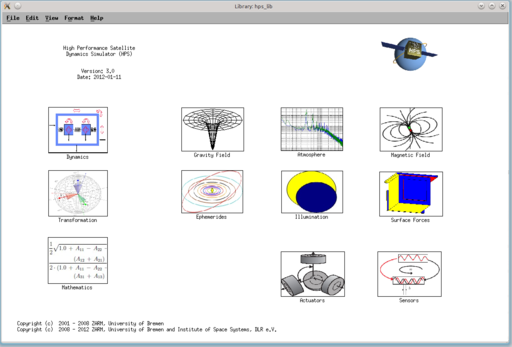Mission simulations

Orbit propagation
Orbit propagation is a central task in mission design, analysis and operations. A dynamical model of the spacecraft and the respective environment enables the evaluation of a mission profile with respect to the requirements and the optimization of mission planning and scheduling. Furthermore, in conjunction with orbit determination, orbit propagation delivers the means for a systematic investigation of disturbances, the uncovering of error sources and the mitigation of perturbing effects. We develop numerical tools for orbit propagation that allow an improved representation of the satellite system and the space environment. We aim at an improvement in modelling accuracy and work on modular modelling approaches offering a broad range of applications.
High Performance Satellite Dynamics Simulator (HPS)
The goal of any scientific satellite mission is the derivation of the experiment's result by analysing the collected data. In order to prepare this data reduction process in advance to the mission simulations are carried out which are used to study the dynamics of the experiment inside the satellite and the satellite's interaction with the space environment. Besides the results of these simulations are utilised during the design phase to support the development process which will at least improve the experiment's performance.
The development of a comprehensive simulation that represents a scientific mission and includes aspects like satellite design, control of the payload and environmental disturbances is very complex. In this scope a simulation tool is developped at ZARM in cooperation with the DLR Institute of Space Systems since July 2008: the High Performance Satellite Dynamics Simulator (HPS). This tool is based on the former ZARM Drag-Free simulator project. The source code of the HPS is written in different languages with a common user interface in Matlab/Simunlink. All modules are available in a seperate HPS Simlink library which provides a good adaptability for the user.
The main focus of the HPS is the simulation of so-called drag-free satellites, which are often used in missions investigating phenomena in the area of fundamental physics. These satellites are usually equipped with several accelerometers. Hence the HPS provides the possibility to simulate a satellite with up to four accelerometers, each containing two test masses.
High Performance Satellite Dynamics Simulator for Satellite Gravimetry (HPS-SG)
The project aims at the development of a high performance satellite gravimetry simulation environment (based on the HPS library), which can be used to model and evaluate the geodetic measurement concepts and systems developed within the CRC geo-Q. www.geoq.uni-hannover.de
The focus of the intended works lies on
i) a precise modelling of the interaction between sensors and system,
ii) a precise modelling of the interaction between the system and the environment (including the influence of the detailed satellite and payload geometry), and
iii) the developement of a modular modelling approach targeting a fast and flexible assembly of different measurement concepts or mission simulations.
With this simulation environment we will provide infrastructural support for all projects in the CRC geo-Q, in particular for the assembly of so-called "mock data sets", and we will try to uncover unresolved disturbance effects in GRACE sicence signals. We will furthermore contribute to an optimization of the performance of geodetic measurement concepts in general by means of parameter studies for different geodetic mission concepts.


 "
"